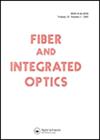宽带定向耦合器光不对称弯曲波导优化的简化方法
IF 2.3
4区 物理与天体物理
Q2 OPTICS
引用次数: 0
摘要
摘要光宽带定向耦合器(bdc)是功能光子集成电路(PICs)中提供波长不敏感和灵活分光的必不可少的器件。现有的BDC器件结构通常需要针对不同的波导结构和工作波段确定特定的设计参数。为了避免这种困境,我们提出了一种新的优化方法,利用非对称弯曲波导结构实现紧凑的BDC。采用多用途粒子群优化(PSO)技术确定了不同耦合比下紧凑型宽带非对称弯曲定向耦合器的最优器件参数。为了降低优化过程中的计算复杂度,首先采用改进的有效索引法(MEIM)将三维ACDC转换为等效的二维结构。以波长平坦化耦合比为目标函数,利用粒子群算法对等效二维ACDC的器件参数进行优化。然后,将优化后的二维结构转换为包含波导厚度的三维结构。为了应对MEIM的逼近误差,3D ACDC进一步微调,通过完整的3D模拟扫描器件参数,但保持从PSO获得的所有其他最优参数不变。因此,在1.50µm到1.60µm的波长范围内,以非常小的6µm耦合长度获得了带宽为100 nm的直流。半优化的ACDC用于构建非平衡马赫-曾德尔干涉仪(MZI)和Sagnac环镜(SLM),两者在较宽的波长范围内具有>25 dB的高消光比和较低的过量损耗。本文章由计算机程序翻译,如有差异,请以英文原文为准。
Simplified Approach for Optimizing Optical Asymmetric Curved Waveguides of Broadband Directional Couplers
ABSTRACT Optical broadband directional couplers (BDCs) are indispensable components for providing wavelength-insensitive and flexible optical splitting in the construction of functional photonic integrated circuits (PICs). The existing BDC device structures are usually required to determine specific design parameters for different waveguide structures and operating wavelength bands. To circumvent this dilemma, here we present a novel optimization procedure to realize a compact BDC by using the asymmetric curved waveguide structure. The versatile particle swarm optimization (PSO) technique is adopted to determine the optimal device parameters of the compact and broadband asymmetric curved directional couplers (ACDCs) for different coupling ratios. In order to reduce the computational complexity in the optimization, the 3D ACDC is first converted to an equivalent 2D structure by using the modified effective index method (MEIM). The device parameters of the equivalent 2D ACDC are optimized by the PSO with the objective function of a wavelength flattened coupling ratio. Afterward, the optimized 2D structure is converted to the 3D one by including the waveguide thickness. To cope with the approximation error by the MEIM, the 3D ACDC is further fine-tuned by sweeping one of the device parameters with the full 3D simulation but keeping all of the other optimal parameters obtained from the PSO intact. As a result, a DC with broad bandwidth of 100 nm is obtained over the wavelength range from 1.50 µm to 1.60 µm with a very small coupling length of 6 µm. The semi-optimized ACDC is used to construct an unbalanced Mach-Zehnder interferometer (MZI) and a Sagnac loop mirror (SLM), both of which show high extinction ratios of >25 dB over a broad wavelength range with low excess loss.
求助全文
通过发布文献求助,成功后即可免费获取论文全文。
去求助
来源期刊
CiteScore
3.40
自引率
0.00%
发文量
4
审稿时长
>12 weeks
期刊介绍:
Fiber and Integrated Optics , now incorporating the International Journal of Optoelectronics, is an international bimonthly journal that disseminates significant developments and in-depth surveys in the fields of fiber and integrated optics. The journal is unique in bridging the major disciplines relevant to optical fibers and electro-optical devices. This results in a balanced presentation of basic research, systems applications, and economics. For more than a decade, Fiber and Integrated Optics has been a valuable forum for scientists, engineers, manufacturers, and the business community to exchange and discuss techno-economic advances in the field.

 求助内容:
求助内容: 应助结果提醒方式:
应助结果提醒方式:


